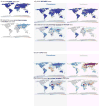HIV and Cardiovascular Disease: Update on Clinical Events, Special Populations, and Novel Biomarkers
- PMID: 29752699
- PMCID: PMC6230511
- DOI: 10.1007/s11904-018-0400-5
HIV and Cardiovascular Disease: Update on Clinical Events, Special Populations, and Novel Biomarkers
Abstract
Purpose of review: The objective of this review is to provide an update on the link between HIV infection and cardiovascular disease (CVD). We will focus our review mainly on literature describing clinical CVD events and understudied topics of importance.
Recent findings: Heart failure, peripheral artery disease, and stroke are CVD modalities deserving more attention in the context of HIV infection in the highly active antiretroviral therapy era. Incidence data on clinical CVD from HIV populations in low- and middle-income countries are limited. Multisubstance use is common in HIV, but understudied as a moderator or mediator of the association between HIV and CVD. CVD risk assessment in HIV remains challenging, but new research into novel biomarkers may provide further insights. There is also a need for inclusion of non-biologic factors in our attempts to understand, quantify, and predict CVD risk among PLWHA. Significant attention has been paid to generating and testing hypotheses to understand the mechanisms of myocardial infarction in HIV. Similar attention is deserving for heart failure, PAD, stroke, and cardiovascular disease risk in resource-limited settings and among substance users with HIV.
Keywords: CVD; CVD risk; Cardiovascular disease; HIV; PLWHA; Review.
Figures

Similar articles
-
HIV Infection and Incidence of Cardiovascular Diseases: An Analysis of a Large Healthcare Database.J Am Heart Assoc. 2019 Jul 16;8(14):e012241. doi: 10.1161/JAHA.119.012241. Epub 2019 Jul 2. J Am Heart Assoc. 2019. PMID: 31266386 Free PMC article.
-
The Canadian HIV and aging cohort study - determinants of increased risk of cardio-vascular diseases in HIV-infected individuals: rationale and study protocol.BMC Infect Dis. 2017 Sep 11;17(1):611. doi: 10.1186/s12879-017-2692-2. BMC Infect Dis. 2017. PMID: 28893184 Free PMC article.
-
Cardiovascular disease risk among women living with HIV in North America and Europe.Curr Opin HIV AIDS. 2017 Nov;12(6):585-593. doi: 10.1097/COH.0000000000000413. Curr Opin HIV AIDS. 2017. PMID: 28832367 Free PMC article. Review.
-
Complications and side effects. Falling rates of heart attacks.TreatmentUpdate. 2009 Mar-Apr;21(3):8-9. TreatmentUpdate. 2009. PMID: 19623729 No abstract available.
-
Recent Insights Into Cardiovascular Disease (CVD) Risk Among HIV-Infected Adults.Curr HIV/AIDS Rep. 2016 Feb;13(1):44-52. doi: 10.1007/s11904-016-0301-4. Curr HIV/AIDS Rep. 2016. PMID: 26910597 Free PMC article. Review.
Cited by
-
HIV Infection and Incidence of Cardiovascular Diseases: An Analysis of a Large Healthcare Database.J Am Heart Assoc. 2019 Jul 16;8(14):e012241. doi: 10.1161/JAHA.119.012241. Epub 2019 Jul 2. J Am Heart Assoc. 2019. PMID: 31266386 Free PMC article.
-
Identifying the needs of older people living with HIV (≥ 50 years old) from multiple centres over the world: a descriptive analysis.AIDS Res Ther. 2023 Feb 12;20(1):10. doi: 10.1186/s12981-022-00488-7. AIDS Res Ther. 2023. PMID: 36782210 Free PMC article.
-
Cardiovascular Risk Estimation Is Suboptimal in People With HIV.J Am Heart Assoc. 2024 May 21;13(10):e029228. doi: 10.1161/JAHA.123.029228. Epub 2024 May 18. J Am Heart Assoc. 2024. PMID: 38761071 Free PMC article.
-
Temporal variations in and predictive values of ABG results prior to in-hospital cardiac arrest.J Med Surg Public Health. 2024 Dec;4:100143. doi: 10.1016/j.glmedi.2024.100143. Epub 2024 Oct 20. J Med Surg Public Health. 2024. PMID: 39867592 Free PMC article.
-
The heart and HIV therapy: exploring the dual cardiovascular impact of antiretroviral treatment - a narrative review.Ann Med Surg (Lond). 2025 Jun 10;87(8):5012-5028. doi: 10.1097/MS9.0000000000003465. eCollection 2025 Aug. Ann Med Surg (Lond). 2025. PMID: 40787484 Free PMC article. Review.
References
-
- Sun D, Wu Y, Yuan Y, Wang Y, Liu W, Yang J. Is the atheroscle-rotic process accentuated under conditions of HIV infection, anti-retroviral therapy, and protease inhibitor exposure? Meta-analysis of the markers of arterial structure and function. Atherosclerosis. 2015;242(1):109–16. - PubMed
-
- D’Ascenzo F, Cerrato E, Calcagno A, Grossomarra W, Ballocca F, Omede P, et al. High prevalence at computed coronary tomography of non-calcified plaques in asymptomatic HIV patients treated with HAART: a meta-analysis. Atherosclerosis. 2015;240(1):197–204. - PubMed
Publication types
MeSH terms
Substances
Grants and funding
LinkOut - more resources
Full Text Sources
Other Literature Sources
Medical
Research Materials

